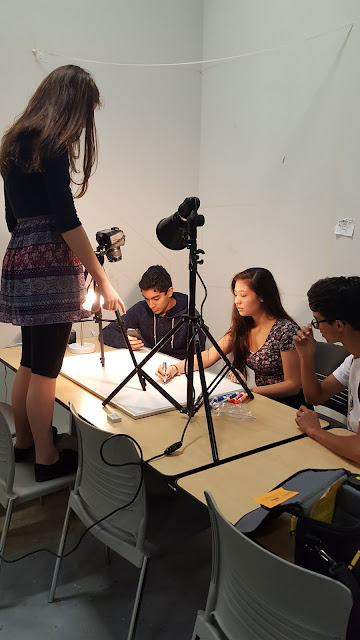 |
| Students of the Environmental Engineering elective show off their projects. |
Editor's Note: DRSS's Engineering Career Tech Pathway is now Powered by Vectren. Learn more about this new partnership here!
By Neeti Prasad, 8th Grade
Ms. Kathryn Reilly is the teacher of the
new Environmental Engineering (EE) elective for juniors and seniors. I
interviewed Ms. Reilly about the main purpose of the class.
Engineering is in our school name, so you
know how passionate students feel about it. For this reason, DRSS created this
new elective for juniors and seniors, so that they could explore this field of
engineering. I first asked Ms. Reilly about the kinds of students that she
would recommend this class to, and she answered by saying that this class is
great for any student who is “interested in research,
problem solving, ethics, discussion, and collaboration.” If you enjoyed the Sustainability class in 6th Grade,
EE would be an ideal choice for you.
Classes like this one can be both fun and an opportunity to learn
important concepts. I asked Ms. Reilly about the major points that she would
want her students to get out of the class. She said the following, “I hope students leave the class with a
better understanding of some of the behind-the-scenes procedures environmental
engineers handle. Behind every good investigation and cool lab there is a lot
of research, discussion, ethics, and note-keeping. I also hope students will
leave with a sense of awareness about the world and with a desire to do their
part to make it better.”
A class at STEM is not complete without a couple of good projects
and the new EE class is no exception. In the water quality unit, students first
collected water samples from the drainage ditch, puddles, sinks, drinking
fountains, and bathrooms. They then analyzed these water samples for potability
and wrote a case study to see if the water quality was within safe limits. They
completed multiple tests for 5 different categories. They conducted a turbidity
test which is the test to see how clear the water is, to make sure that there are
no sediments or dust in the water. Next they did a pH test, to see how acidic
the water. After that the students checked to see how much ammonia, nitrates,
and sulfates were in the water. If you want to figure out if the water you are
drinking is safe, you know who to go to now!
Our education lays the foundation for our eventual careers. So I asked
Ms. Reilly about the impact of this class on a student’s future. “This class could give students an idea of
the type of day-to-day activities an environmental engineer carries out to
determine water quality, food solutions, or renewable energy.” She went on
to say that this class could help narrow down possible career choices for
students.
This is a brief introduction to what this environmental
engineering class is. If you would like to learn more about this class, contact
Ms. Reilly. So, a big welcome to Environmental
Engineering from all of us at the Dayton Regional STEM School, and thank you to Vectren for powering our bright future!


















